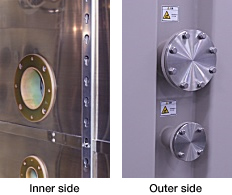Combined Sequential Cold, Low Air Pressure and Damp Heat Test
- Test summary/features
-
Combined sequential cold, low air pressure and damp heat tests have been done mainly for quality evaluations of electronic devices for aircraft use. The increasingly compact sizes of today's mobile phones, digital cameras and other consumer electronics products is making their use in low-pressure environments such as aircraft, mountain-tops and skyscrapers no longer negligible.
- Causes and examples of quality problems caused by low-pressure environments
-
- Leakage of gas and liquid sealed at normal pressure: Condenser liquid leakage, flat panel display image deterioration
- Deformation or damage in sealed packaging boxes or structures: Packaging bag damage, buffer material expansion
- Short-circuiting, smoking or fire from arcs (discharges) in high-voltage charged parts: High-voltage transformer smoking, camera flash lighting failure
- Loss of radiant heat, cooling fan efficiency drops from component temperature rises/localized heating: CPU cooling failures
- Lubricant evaporation
Test method (main standards supported)
| Standard No. | Standard name | Summary of test conditions | Devices covered |
| JIS C8712 (UN Manual of Test and Criteria, Part Ⅲ, 38.3.4.1 Test T.1) |
Safety Requirements For Portable Sealed Secondary Cells | 20°C±5°C/11.6kPa min. for at least 6 hours | Secondary batteries |
| UL1642 | Lithium Batteries | 20°C±3°C/11.6kPa min. for at least 6 hours | Lithium-ion batteries |
| MIL-STD-810C method 504.1 category 4 |
Environmental Test Methods | -62 to +85°C at altitude of 30,000 feet |
|
| JIS W 0812 (RTCA/DO-160D) | Airborne equipment: Environmental conditions and test procedures | -55 to +85°C at altitude of 15,000 to 70,000 feet (57.18 kPa to 4.44 kPa) | Devices for aircraft use |
- Test equipment
-
ESPEC's test equipment can be used for evaluating the quality of electronic devices for aircraft use, and for simulating the transport environment of products shipped by air. It enables environmental tests of electronic devices designed for use in low-pressure environments, such as devices exported to high-altitude cities overseas.
- Equipment particulars
-
- Altitude Chamber (installed at Kobe and Utsunomiya Test Centers)

| Main specifications of Altitude Chamber | ||
| Model | MZH-32H | MZT-32S |
| Temperature range | -70 to +180°C | -60 to +100°C (Atmospheric pressure to 10.7 kPa) |
| Humidity range | 20 to 95%rh (No humidity control under low pressure) |
- |
| Pressure range | Atmospheric pressure (101.3 kPa/760 Torr) to 0.1 kPa (1 Torr) (equivalent to altitude of 150,000 feet) | |
| Internal dimensions | 1500 × 1500 × 1500 mm | |
| Safety features | - | H2 gas detection, CO gas detection, automatic CO2 fire-extinguisher functions |
| Installation location | Kobe | Utsunomiya |
- Connections for signal wires/supplying power to test samples
-
Cable ports providing access to test chamber interiors are provided for cables used to supply power to test samples or open/close electrical contacts.
Before cables can be supplied to a test chamber, a pressure-resistant flange must be added to make the chamber pressure-resistant (prevent air leakage).
Altitude/low-pressure testing involves many issues that must be discussed beforehand such as the test sample placement method and power supply method.
These issues should be discussed as early as possible in the test planning phase.
<Cable port>

